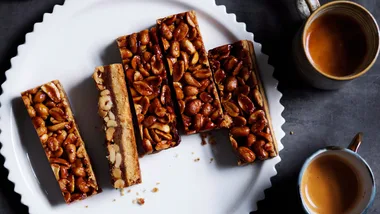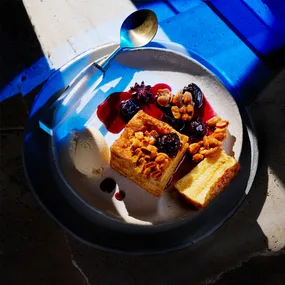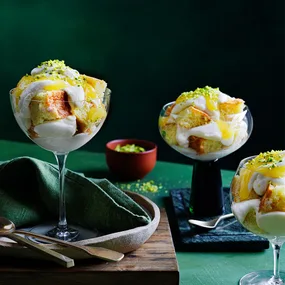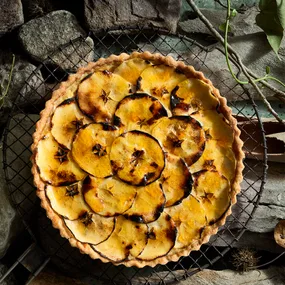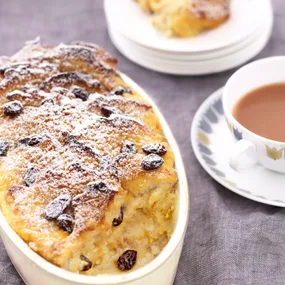One of the most famed French desserts, crème caramel – a winning combination of just two components – is testimony to the notion the simplest things are often the best. And of course success lies in making each of these components, custard and caramel, the best they can be.
The custard
Starting with the custard, the first step is to whisk together the eggs and sugar, and I find for the best result the mixture should then be left to stand for a few hours so the sugar dissolves completely before adding the milk. You can make a successful crème caramel without this step, but taking the extra time makes for a glassy, shiny-looking custard with a smoother texture.
The custard can be made and refrigerated for two to three days. In this case, the milk can be added to the egg-sugar mixture cold before refrigerating. If you’re going to bake it straight after the egg and sugar have stood for a few hours, however, this will make a perfectly fine crème caramel, but warm the milk to around 65C before adding it to the egg-sugar mixture to start the cooking process.
You can also use half milk and half cream if you want a richer and thicker result, but I find custard made with just milk is more refreshing. Perfectly textured custard has the most moisture bound by the least structure and a set ratio ensures the custard always sets properly regardless of size; I go by two eggs to 250ml liquid with 15 to 20 per cent sugar. When the sugar deviates too far from the right percentage, it can prevent the custard setting. And it will be too sweet.

Step 2.
The caramel
For the caramel, ensure your saucepan is super-clean and free of grease. Put the water in first, then sprinkle the sugar over it so you don’t have a dry layer of sugar on the base that will burn. Stir the sugar syrup gently so you don’t splatter it up the side of the pan; it’ll form crystals and ruin the caramel. Cook the caramel quickly over high heat. At first, I place an upturned bowl on top of the saucepan – the curve builds the condensation then it runs down into the pan, washing the sugar from the sides. Once the mixture is boiling, remove the bowl and keep a vigilant eye on the syrup without touching it. If the caramel does crystallise, unfortunately you need to start again; there’s no going back.
The French cook their caramel until it reaches a very deep amber colour, so it has a really rich caramel flavour. It’s easy to let it burn from here, though, so be sure to have your baking dish ready to tip the caramel straight in; it’s so hot it will keep on cooking even when poured into a cold mould.
To know when the colour is right, tip the saucepan to the side so you can see a thin layer of caramel on the base – the caramel looks a lot darker in volume. You need to stop the cooking before it starts smoking or the caramel becomes bitter; too pale, though, and it won’t have the depth of flavour you need – there’s nothing more disappointing than turning a crème caramel out that’s pale in colour. Hot caramel also gives a nasty burn, so be very careful while you work with it, too.

Step 4.
Preparing your crème caramel
The cooking time for the custard varies depending on the mould you use. Here I’ve used a large straight-sided shallow dish, but you can also use individual ramekins.
If you are using small ramekins, pour the caramel into each, then quickly go back and swirl each around to coat the sides. With a large one, swirl the caramel around by tilting and rotating the dish. Coating all the sides ensures the caramel flavour is evenly distributed, and also makes it easier to remove the crème caramel from the moulds; it helps to prevent cracking as it cools, too.

Step 5.

Step 6.
Baking your crème caramel
When you’re ready to cook the crème caramel, spoon the foam off the top of the custard, then pour the custard into the prepared dish. It needs to cook slowly and evenly in a water bath, which softens the heat, and at no more than 160C; if the temperature is too high, bubbles will pock the surface of the custard.
Place a tea towel in the bottom of a roasting pan and, once the custard is in place, pour in hot tap water – boiling water is too hot, while cold water takes too long to heat – to come two-thirds up the sides of the dish. Cover the dish with foil to protect the surface of the custard from heat, and pierce a few holes in it to let the steam escape, then bake the custard until it’s set with a slight wobble in the centre when jiggled. If you overcook it, the proteins in the eggs keep bonding and then start squeezing out liquid, which produces a cracked custard with a watery, bubbly consistency. While I have fond memories of eating curdled custard on toasted brioche with prunes soaked in Armagnac when I was an apprentice, this is something you’ll want to avoid.

Step 7.
Let your custard set
Once it’s cooked, uncover the custard and leave it in the water bath to cool to room temperature, then refrigerate it for at least 12 hours, or overnight. As the custard cools, very gently pry the edges away from the side of the dish with damp fingers to prevent it from catching and cracking. To remove the custard, release the vacuum in the same way, then place a plate on top and quickly and smoothly invert it.

Step 9.
You can flavour the custard with orange rind, say, and other spices such as cinnamon; here we’ve gone with classic vanilla bean seeds. To serve this I like nothing more than a good helping of caramel from the dish spooned on top to really enjoy the flavours of caramel and milk combined, and its beautiful silky consistency.
This recipe can be started up to three days ahead to make the custard.
 Rob Shaw
Rob Shaw
